The countdown is on with only a few days to go before the doors open on the world’s leading trade fair for lighting and building-services technology in Frankfurt am Main. And this major event for the sector is already proving to be very popular. More than 2,000 national and international exhibitors have registered to present their innovations to a wide audience of trade visitors. They include numerous market leaders who will be showing their latest products for the fields of lighting, electrical engineering, home and building automation and networked safety and security technology.
The next Light + Building will be held from 3 to 8 March 2024, and after Germany, the best-represented nations to date include Italy, Turkey, Spain, Poland, the Netherlands, Great Britain, France, Belgium, Greece and China. “There is a high level of interest in taking part again in 2024, on both the lighting and building sides. We are delighted about the many loyal customers who took part in the last edition of the fair, as well as about a whole series of returning exhibitors. They all ensure that Light + Building is the unrivalled, international highlight for the lighting and building-technology sectors”, says Johannes Möller, Head of Light + Building Brand Management. Expanding on this, he adds: “There have been some changes at the Exhibition Centre, which have opened up new planning options for us.”
Experts for lighting with a new structure
Covering the spectrum from offices and educational facilities to the industry, retail trade and hotel business, Light + Building brings together experts for intelligent lighting solutions at the Frankfurt Fair and Exhibition Centre. Altogether, this theme occupies around 64 percent of total exhibition space. New in this connection is the layout of the product segments, which has been made possible by the inclusion of the new Hall 5 with two modern floors that are open to Light + Building exhibitors for the first time. This creates a new circular route in the eastern section of the Exhibition Centre, which runs from Halls 5 and 6, via the Forum and Hall 3, to Hall 4, and is made effortless by the Via Mobile system of moving walkways.
What can visitors expect in which halls?
The market leaders from the ‘technical lighting’ segment are to be found in Halls 3.0, 5 and the Forum. The exhibitors showing their latest products include Bega, Brumberg, Glamox, iGuzzini, Leds C4, Ledvance, Lichtwerk, Molto Luce, Normagrup, Regiolux, Ridi, RZB, Simes, Thorn, Tridonic, Trilux, XAL and Zumtobel.
Hall 3.1 focuses on decorative and technical, design-oriented lighting with presentations being made, for example, by Artemide, Delta Light, 3F Filippi, Linea Light, Marinelli Luce, Prolicht and Targetti.
Urban lighting for streets and public places will be shown by many companies including AEC Illuminazione, Benito Urban, Carandini, Eclatec, Fonroche, Leipziger Leuchten, Metalogalva, Ragni and Valmont in Hall 4.0. A floor higher, in Hall 4.1, visitors will find not only lighting for industry and special applications but also shop and theatre lighting, as well as emergency and safety lighting. Among the exhibitors taking part there will be Barthelme, Deko Light, Eaton, Inotec, Nobilé, Opple, Robus, Rutec, Radium, RP Group and SG Armaturen.
The complete spectrum of decorative lighting is located in Hall 6 where the exhibitors include Authentage, Elstead Lighting, Fan Europe, Konstsmide, Lucide and Nordlux, plus the companies taking part in the Turkish pavilion.
The lighting sector also occupies part of the western section of the Exhibition Centre and, for the first time, takes up the whole of Hall 8. With the focus there on lighting components, sources of light and lighting control systems, the exhibitors presenting their latest products include Bender + Wirth, BJB, Nichia, Osram, Seoul Semiconductor, TCI, Vossloh-Schwabe and Wago.
Hall 10.1 and 10.2 are devoted to Asian lighting manufacturers in the Asia Selection segment.
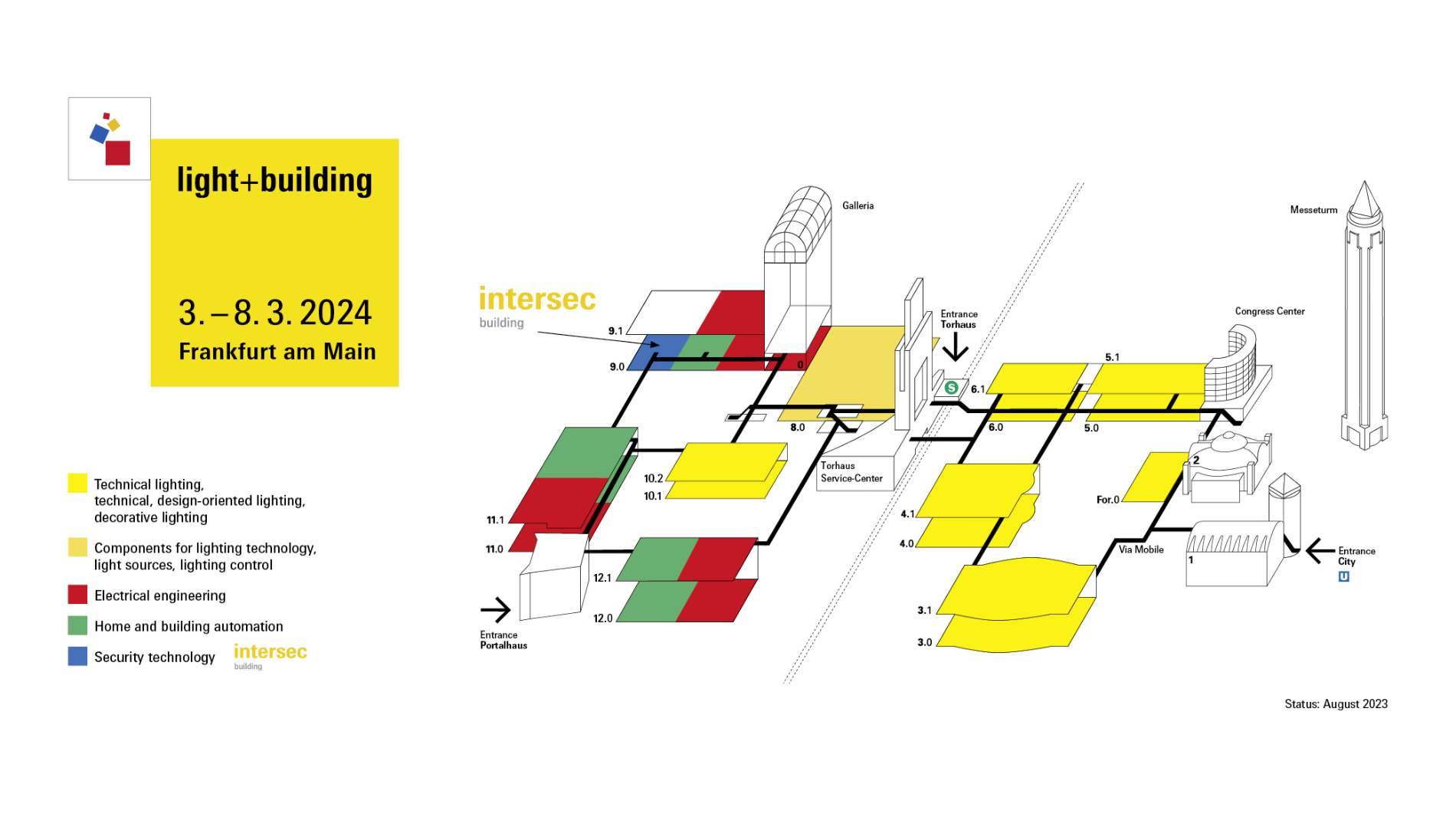
Looking ahead with intelligent building-services technology
Based on the electrotechnical infrastructure, tomorrow’s sustainable houses and buildings will use renewable sources of energy, have efficient and economical energy management, and, at the same time, offer a high degree of comfort, safety and security. The electrotechnical infrastructure is the prerequisite for home and building automation, energy storage and management, the connection of photovoltaic systems and charging stations and electricity-based heating systems. The latest products, technologies and trends for electrical engineering and home and building automation will be the focus of attention in Halls 9, 11 and 12.
Many of the sector’s key players have already confirmed their participation in the fair. In Hall 12.0, they include ABB, ABL, Bals, Bosch Thermotechnik, Busch-Jaeger, Dehn SE, Kaiser, Niedax, SMA, Stiebel Eltron, Theben, Viessmann and Warema. A floor higher, in Hall 12.1, the exhibitors will include Doepke, Fränkische Rohrwerke, Hager, Mennekes, Hensel, OBO Bettermann and PCE.
The extensive range of electrotechnical and home and building-automation products continues in Hall 11.0 with exhibitors such as Beckhoff, Phoenix Contact, Rittal, Siemens, Wago and Weidmüller. In Hall 11.1 the companies taking part include Gira, Jung, Legrand, MDT, Schneider Electric and Siedle.
The safety and security technology segment has also been expanded under the heading ‘Intersec Building’ and can be found in Hall 9.0. Among the exhibitors there showing solutions for connected safety and security technology will be Abus, BKS, Dom, Gretsch Unitas, Grothe and Winkhaus. In addition, the range of products and services for electrical engineering, house and building technology continues in Hall 9.0. Here, Bacnet, EnOcean, frogblue, Loytec, Megger, Thermokon and Woertz show their innovative products.
You can find the Interactive Hall Plan 2024 here.
Light is such an important part of our lives that more and more people are looking to further their understanding of it, either through self-education or by seeking the guidance of experts. There’s so much to get from a lighting design degree: colour theory, the influence of light in our circadian rhythms, how light diffusion works, the materials and the perfect light for them, and much more.
Read on to discover some of the best lighting design schools, courses and universities.
Ryerson University’s School of Interior Design pushes students to engage in experimentation and academic research, combining both approaches to help them grow and discover themselves in design. Recognized by many as one of the top international design schools, RSID aims to prepare the leaders of tomorrow in each design field.
Their Lighting Specialization program is fully online and intended for those who already have some background in other areas of design, such as interior design and architecture. This specialization is meant to acclimate designers to new legislations that limit energy budgets, which are probable to get more serious as time goes on. This environmentally conscious approach to education is supported by the possibility of getting in touch with professional lighting designers through a final project that will not only enrich the students’ curriculums but also give them hands-on experience.
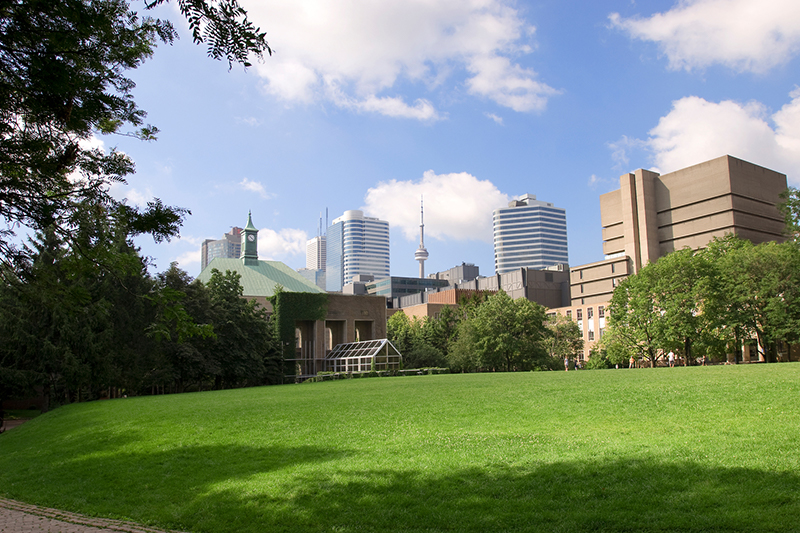
The Parsons School of Design is widely considered the best design school in the United States and one of the best worldwide, having always sought inspiration from the transformative potential of design. With groundbreaking academic programs that take on an interdisciplinary approach complemented by the cultural and artistic richness of New York City.
Parson’s Lighting Design program was the first of its kind ever to be created in the world, more than 45 years ago. Such a long and pivotal history means that some of the leaders in the lighting design field have come directly from here – who knows, maybe your favourite designers studied here! The foundation of the program is the intellectual, aesthetic, and technical qualities of light, which are complemented by the social impact, human experience, and sustainability of lighting design. If New York, rich artistic history, and a comprehensive study of light are what you are looking for, then Parson’s must be calling out for you: our advice is to follow since you’re sure to get everything you need (and more) to be able to leave your mark in the lighting design world.

POLI.design is the design school founded by the Politecnico di Milano, right in the middle of one of the capitals of design. The allure is obvious: Italy, one of the very best schools of design, and an electric combination of art and culture. Apart from this, the design programs are widely known as part of the world elite in the field, all due to the incredible faculty, comprehensive teaching methods, and the array of opportunities that open up for the students.
Poli Design’s Master in Lighting Design and Technology strives to train professionals able to follow the design procedures of lighting, making sure that their students are well acclimated with the various methodologies of conception, organization, and implementation. This Master understands how impactful light can be in our well-being, in how we communicate with others, and in how we view the world. If your passion is the influence of light on humans and how it can affect businesses, relations, and any human activity sectors, plus if you would love to spend your study sessions in an Italian library with a cappuccino, then we invite you to further check this one out.

The Wismar University planted its roots in Germany in 1908 and has since been growing its majors and influence. The original design school was set on Germany’s seaside, which was surely beautiful, but when it was transferred to the Wismar campus it truly began to bloom. The international environment and interdisciplinary possibilities allowed the Hochschule Wismar to grow into what is now one of the best in the world.
Their Master in Lighting Design is fully taught in English and promises a wide range of nationalities, so your peers will be of great influence to your learning and great collaborations are to be expected. The teaching is divided into theoretical and practical courses, and students are presented with the various impacts and possibilities of both artificial and natural light in architecture and social spaces. Apart from this, the effects of light in humans are thoroughly studied, so that students are given all the information they need to make the best lighting designs possible. Knowing this, if you are someone who loves diversity, socializing with people from other countries, and having a collaborative and comprehensive education, our tip is to go for this one!
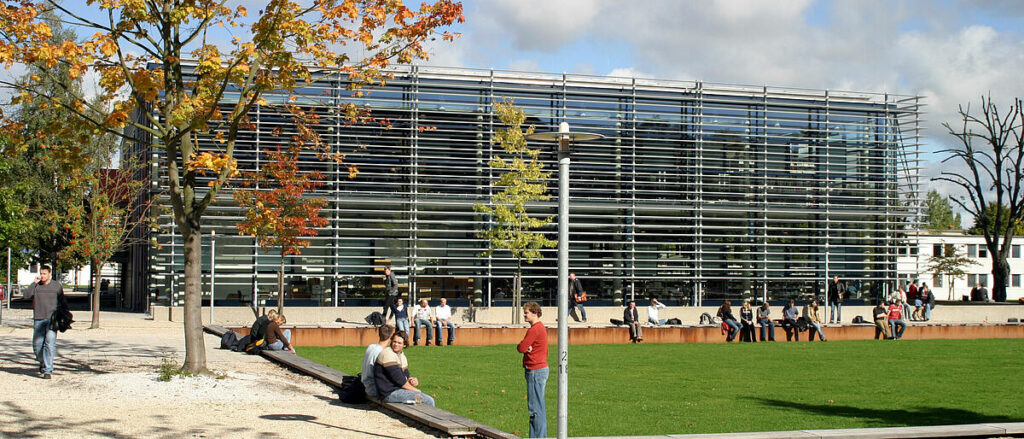
The KTH is one of the largest institutions in Sweden for technical education and research, attracting students and professionals from all over the world. Their technical focus makes them one of the most important contributors to the innovation of design fields. This prestigious position is sure to be maintained as KTH focuses more on sustainability and ecological challenges.
KTH Royal Institute of Technology offers a Master’s in Architectural Lighting Design, one of the best out there. The program researches the influence of light on the human body and psyche, trying to find the best ways to enhance how we benefit from light. This Master’s is meant for those who already have an understanding of light planning and how to work a project so that students can truly grow their understanding of this almost magical element.
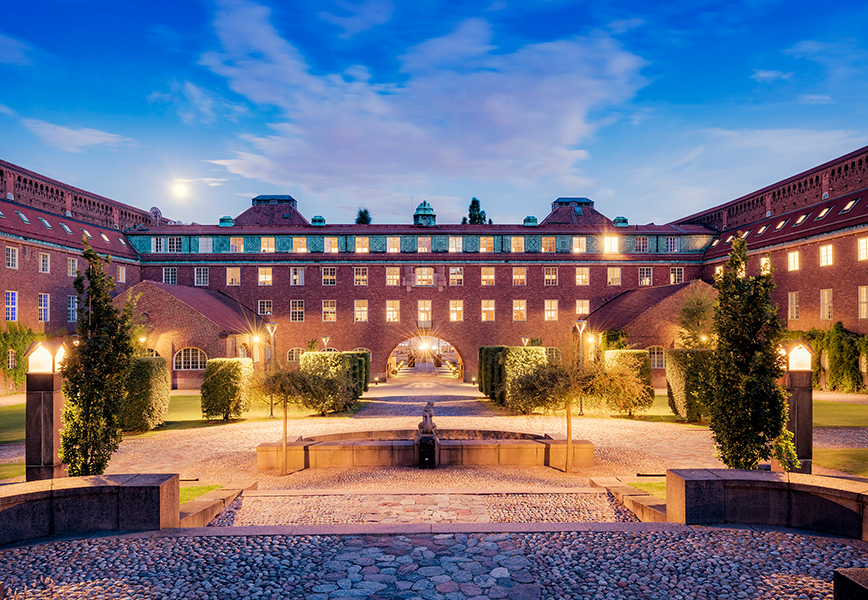
The University of Technology Sydney has been sharing its knowledge and producing leaders in the many fields society depends on (such as design, obviously) for more than 170 years, making it a proud member of the top 20 universities in the world.
Their Master in Architectural Science (Illumination Design) mixes strong technical subjects with human perception, creating a long curriculum where technology, lighting qualities, and sustainability are the stars. If you decide to apply and end up enrolling, you can expect to gain a newfound respect for the many ways light shapes our experience of both the world and the built environment.
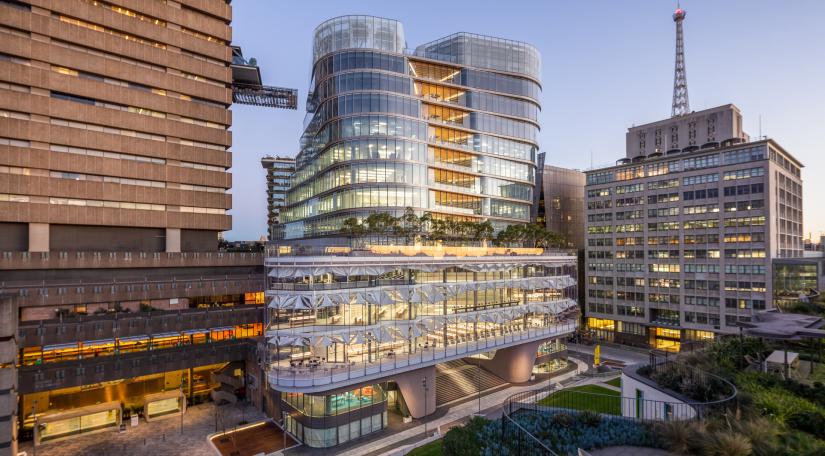
Are you familiar with CalTech? Well, let us introduce you to CalArts, or in its most formal self the California Institute of the Arts, which has been educating professional artists since 1970. Known as one of the best arts schools in the United States, CalArts strives to foster creative excellence, critical reflection, and the development of new forms and expressions in their students.
Their MFA in Lighting Design curriculum centres on developing critical and practical skills in immersive lighting design, lighting technology and platforms, and strategies for live performance across a wide variety of creative arenas. Students are taught how to understand the physiological and psychological effects of light in addition to other scientific principles of phenomenology. Everyone is pushed into finding their voice and aesthetic, ending their time in CalArts with a lot of experience in production work and a vast portfolio.
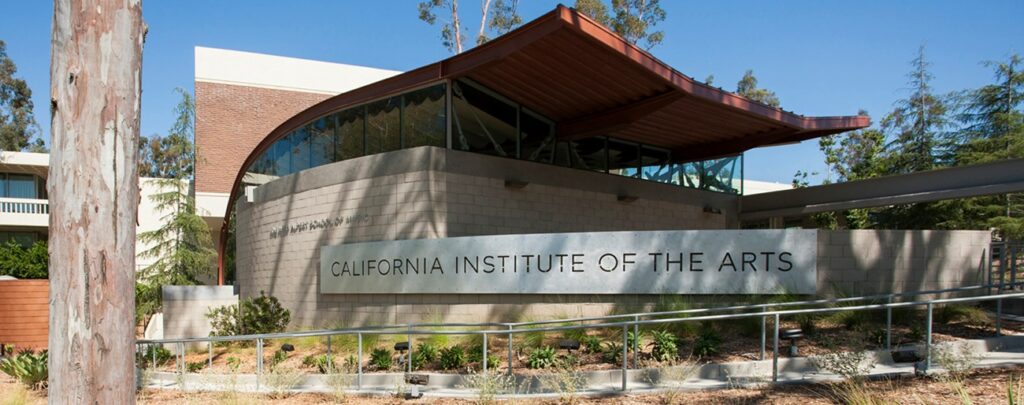
Aalborg University is known in the lighting design realm as one of the best universities to study light and how to channel it to our benefit. The university’s core objective is to discover which are the greatest challenges society and the various academic fields it teaches face, striving to provide sustainable solutions consistently.
They offer an MSc in Lighting Design which covers both artificial and natural light, intersecting it with architecture, media technology, and engineering – quite interdisciplinary. What makes this specific Master unique is its base in Danish and Nordic traditions for light perception, which means they not only focus on the technical qualities of light but also on the aesthetics and comforts it provides.

The University of the Arts London is ranked second in the world for Art and Design, as per the 2022 QS World University Rankings. It offers a wide variety of courses ranging from design, fashion, communication, performing arts, and many others, so it’s no surprise that its MA in Interior and Spatial Design covers many of these artistic fields.
Their MA in Interior and Spatial Design explores how design can challenge world issues and drive positive social change, empowering their students with real-world experiences through their global and regional partners. Light is studied here concerning space and interior design, being completely dissected in the way it interacts with a room and how it affects us. This MA can, in the end, make you rethink your entire approach to design and light, as it covers so many fields and interconnects them with each other.
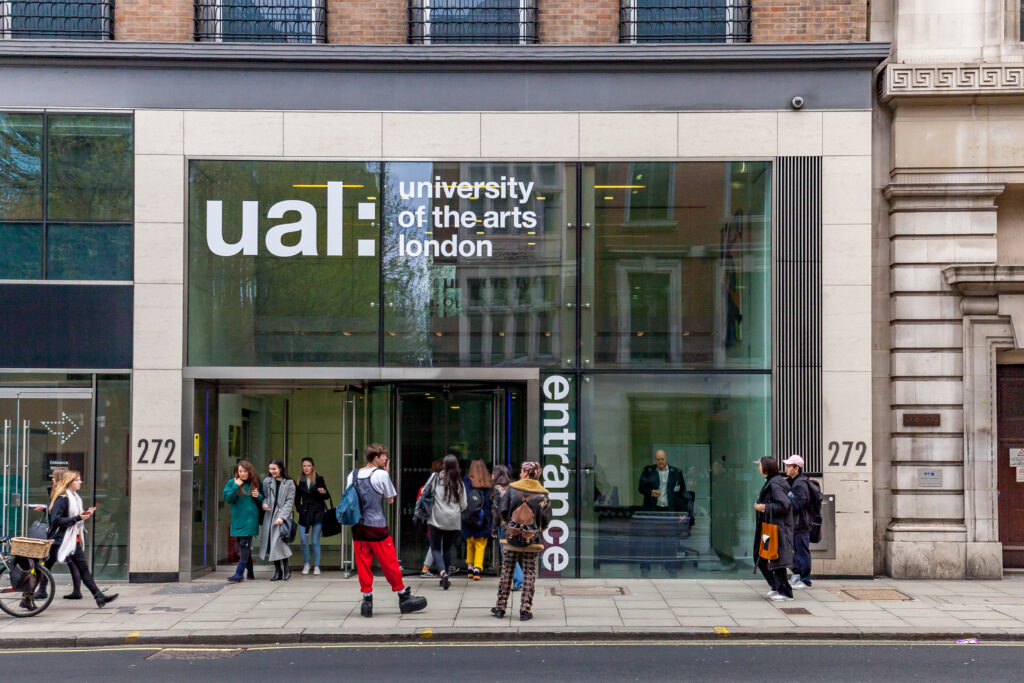
The UCL was founded in 1826 in the heart of London and is considered the most multidisciplinary and international university in the country. Here, progressive approaches, leading experts as professors, and a diversity of peers are sure to give you a boost of creativity and make you see design in a whole new light.
Their MSc in Light and Lighting mixes the human experience with the technical and creative sides of lighting design. It was created in 1987 and has produced some of the world’s leading lighting engineers and designers. From indoor comfort to outdoor safety, light is used to find a solution to society’s issues, making UCL’s students some of the most prepared to tackle any challenges that might appear in the future.
The LIT Lighting Design Awards is officially open for submissions, inviting the world’s brightest minds in lighting design to join its annual celebration of excellence. This distinguished event, renowned for honoring the pinnacle of creativity and innovation, boasts an expansive array of categories, comprising 31 in Architectural Lighting Design, 15 in Entertainment Lighting Design, and an impressive 44 in Lighting Product Design.
In 2023, the program attracted over 800 submissions from 58 countries, showcasing an extraordinary spectrum of work. Notable recognitions included the Architectural Lighting Design of the Year 2023 awarded to ERRELUCE for their remarkable work on IronPlate Restaurant, and the Lighting Product Design of the Year 2023 claimed by Hydrel for their FLAME Lighting Technique. The introduction of the Entertainment Lighting Design of the Year category saw Eleftheria Deko & Associates triumph for their work on “Persephone Reconsiders Her Fate.” Introduced in 2018, the Lifetime Achievement Award celebrated Roger Narboni for his outstanding contributions spanning landscape, urban, heritage, and architectural lighting over 35 years. DarkSky received the prestigious Spotlight Prize for their unwavering commitment to preserving the darkness of the sky.
“At the LIT Lighting Design Awards, we invite you to join us in celebrating the amazing potential of light and its ability to transform the world around us. Our program goes beyond recognizing great designs; it’s about appreciating the positive impact of lighting solutions. We take pride in providing a stage where creative minds come together to showcase their talents while being mindful of the long-term effects on our environment. The LIT Design Awards values the importance of sustainability in lighting design, encouraging designers to share their approaches and contribute to a more environmentally friendly future for our planet,” shared Program Director, Astrid Hébert.
The 2024 jury, composed of 35 experienced designers, lighting experts, academics and media representatives will select the winners in each category in November 2024. Past jurors have included Sooner Routhier, CEO of The Playground, Roland Greil from Roland Greil & The Black Project, Emmy Award Winner Peter Morse; Randy Reid, Editor at designing lighting (dl), Sally Storey, Creative Director at John Cullen Lighting and Founding Director at Lighting Design International, Thiago Gaya, Publisher of L+D Magazine and Founder of the LEDforum, amongst others.
To ensure winners receive the recognition they deserve, LIT Lighting Design Awards have joined forces with notable media partners such as V2com, D5mag.com, Silhouette Awards, World Design Organization, and DesignWanted, guaranteeing extensive global publicity for the awarded projects. Additionally, winners work will be featured in the annual Book of Design distributed worldwide and presented with the coveted LIT Lighting Design Awards certificate and badge of achievement, along with a year-round profile in the LIT Awards Online Directory. Participating in the awards process offers a valuable learning experience, allowing companies to benchmark their work against industry peers and gain insights into areas for improvement.
To encourage early submissions, a 10% Early Bird discount is available until April 28th, 2024. For detailed information and to submit entries, please visit litawards.com. Illuminate your brilliance – be part of the LIT Lighting Design Awards 2024!
The much-anticipated LIT Lighting Design Awards Gala is set to captivate on the 20th of June, promising an evening of brilliance, innovation, and design excellence in the heart of London. The ceremony will take place at the iconic Banking Hall, an Art Deco landmark that stands as a testament to the city’s design culture and architectural brilliance. Overlooking the prestigious Bank of England, this venue provides a stunning backdrop for an evening that will undoubtedly be the highlight of the lighting design world.
The ceremony will feature prestigious winners from 2022 and 2023, including 2023 winners ERRELUCE for Architectural Lighting Design of the Year of the IronPlate Restaurant and Hydrel for Lighting Product Design of the Year, FLAME Lighting Technique. In 2022, L’Observatoire International received Lighting Design of the Year for Hermès’ collections, and Expolight won Lighting Product Design of the Year for the B14 UNIT Chandelier.
Spotlight Prize winners feature DarkSky in 2023 for outstanding commitment to preserving the darkness of the sky, and The Studio School of Design (SSD) in 2022 for remarkable work towards education accessibility, diversity, and inclusivity. Esteemed Lifetime Achievement Awardees include Roger Narboni in 2023 and Patrick Woodroffe, Dave Kavanagh in 2022, recognizing their significant contributions to the lighting industry.
Reserved exclusively for the winners of the LIT Lighting Design Awards from 2022 and 2023, alongside their specially invited guests, esteemed jury board members, and a select group of partners, this upcoming event presents an exceptional opportunity for brands to claim the spotlight at the forefront of the lighting design world. Each honoree will step into the well-deserved spotlight, not only to receive accolades but also to capture the attention of influential media figures and industry leaders. The event is expected to attract significant press coverage and the participation of renowned media names, ensuring widespread recognition and valuable networking opportunities for all involved.
“This event is more than a celebration; it’s a recognition of the innovators who have shaped the landscape of lighting design,” said Astrid Hebert, Program Director of the LIT Lighting Design Awards. “Limited partnership spots are available, offering brands a unique opportunity to be at the forefront of the lighting design world.”
Limited partnership spots will allow chosen brands to gain visibility and recognition within one of the most extensive platforms for excellence in Architectural Lighting Design, Entertainment Lighting Design, and Lighting Product Design. Partners will be able to showcase their brand, engage with industry professionals, and support emerging talents in the dynamic field of lighting design. For those eager to secure one of the limited partnership spots, kindly visit litawards.com to get in touch.
Welcome to an exclusive interview with Chris Sorensen, the Senior Director of Engineering at Hydrel, a leading brand in outdoor architectural and landscape lighting. Hydrel recently won the LIT Lighting Design Award for the Lighting Product Design of the Year with their innovation, FLAME.
FLAME combines a patent-pending optical engine construction with engineering excellence to create a new play on RGBW. It’s a unique lighting technique with two beams in one luminaire – a central beam and an outer beam that blends harmoniously.
Currently available within the SAF7, SAF14, and SAF28 Architectural Family, FLAME offers three distinct distributions, each designed to create stunning accent gradient effects in a single fixture. From the NARROW FLAME, with its 30° outer beam and 10° central beam, highlighting vertical forms, to the WIDE FLAME‘s 70° outer beam and 30° central beam for playful blended textured surfaces, and finally, the LOTUS FLAME, delivering a dramatic lighting effect with a 70° outer beam and 10° central beam.
Join us as we explore the inspiration behind FLAME and gain valuable insights into the vision and expertise that have positioned Hydrel as a premier brand in outdoor lighting.
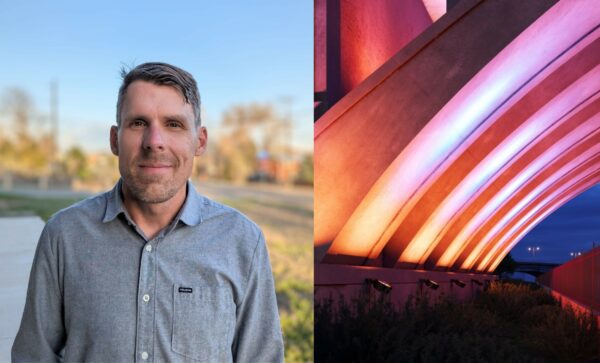
Chris Sorensen, Senior Director of Engineering // FLAME Lighting Technique. Hydrel
What was the vision or inspiration behind the dual beam design (or should we say designs) of FLAME?
We are very inspired by some incredible projection art installations while simultaneously feeling tired of saturated RGB color chases and challenged ourselves to build a new tool with which to paint the night in a new way.
How was the patent-pending optical engine developed and what makes stand out from others?
Leveraging our learnings from the SAF architectural floodlight family, we built, studied, and learned from countless mock-ups and prototypes until we got the best-performing gradients and eliminated distracting artifacts on near and far away surfaces.
Can you tell us about the different designs available – Narrow FLAME, Wide FLAME, and Lotus FLAME? How do you envision each being used?
Narrow and Wide FLAME Distributions are all about the geometry of the architecture from landscape to columns, facades, and bridges, narrow and wide can be applied like traditional projectors however with the gradient color and in washing or grazing positions they will magically transform the appearance of surfaces and objects. We were so captivated when we pointed them at trees that we knew we needed to do something specific. That’s where the Lotus FLAME came from, the desire to distinctly light the trunk with one color and the leaves and branches another with a smooth but quick gradient between the two.
Challenges are part of life, and, therefore, of design. Can you share with us some of the technical challenges you’ve faced during the development of FLAME? What did you learn from them?
Near-field beam artifacts take a highly specialized eye and perseverance to solve. The human eyes and brain can start to play some very interesting games when staring at beams of different saturated colors for hours criticizing gradients, intensity, cutoff, and artifacting.
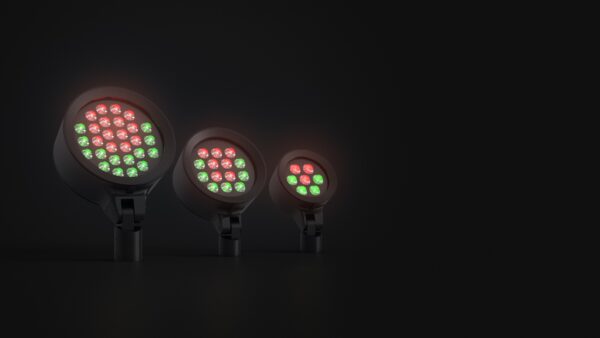
FLAME Lighting Technique. Hydrel
Can you tell us about any project you’re working on at the moment or about any future enhancements for FLAME?
Stay tuned, FLAME is just the start. We have a very exciting follow-up product in development right now!
Congratulations on winning the LIT Awards! What does winning this award mean to you and what are the next steps for Hydrel?
We’re incredibly honored to win this award. We will continue to make the ordinary evening extraordinary and transform the way our world is LIT!
Do you have any advice for people who would like to follow in your footsteps?
Be curious, be brave. It’s never too early to try out your wild idea. Even if it is just in Photoshop. The first FLAME mock-up was done with a Photoshop file where we set up a visual of two beams on top of each other so that we could independently control the color and blending of the beams much like the FLAME visualizer on our website. From that very first file, we knew we had something special!
Takatoku Nishi, emerging winner of the 2023 LIT Lighting Design Award for Architectural Lighting Design, brings us to the magic of his creation, “Ripple.” On sunny days, sunlight dances through ceiling pipes, mimicking drops of water. Nishi’s design captures nature’s unpredictability, offering a unique experience with every visit.
“Ripple” was Nishi’s Ph.D. project, surprising with its location between the zoo and the university. Amid urban surroundings, it boasts lush greenery and wildlife. Nishi’s hands-on approach, considering sunlight, wind, and site shape, resulted in a masterpiece reflecting nature’s accidental beauty. This interview uncovers the inspiration, construction challenges, and the profound connection between “Ripple” and its natural surroundings.
Could you tell us a little about yourself?
I am an artist and PhD based in Tokyo. As a constructor and phenomenon creator, I pursue and research spatial experiences with light. My long-standing focus has been on natural light. I try to reconstruct the phenomenon of light by using materials and structures to sublimate this natural light into artworks. Natural light is familiar to us and is the most beautiful and natural light. I believe that by passing this through the medium of architecture, a new spatial experience can be created.
Apart from pure architectural spaces, I am also interested in installation works that focus on the power and interest of nature. Looking at the power of nature and the beauty of light from different angles gives me new ideas.
Can you share your design philosophy or vision behind Ripple?
Ripple is for me the most ideal space of all the light spaces I have researched and created. In our daily life, “the wind blows and the light shines.” Just this everyday force of nature can create dramatic and beautiful phenomena. This idea is inspired by atmospheric optical phenomena. For example, when it rains and the sky is clear, you can see a rainbow. When light passes through clouds, it also creates beautiful sights such as an angel’s ladder. By manipulating these little coincidences in nature, I came up with a new way of expressing space. Therefore, light phenomena are not always present in the Ripple space. When it is cloudy and raining, light cannot be seen. Similarly, if there is no wind, the phenomena will not move. The spatial experience is also different depending on the wind speed. It is a remarkable day-to-day change. I designed this space to allow people to slowly experience the daily changes. The lighting of the space, the number and spacing of the pipes, the height and width of the space, the spacing, the materials and shades of the floor and walls – all have been calculated to provide a pleasant experience of the phenomenon of light.
Your design incorporates natural elements like the sun and the wind into the design. Can you describe the technical process behind the different light phenomena you’ve achieved through this balance?
The most time-consuming part of the research was the mechanism for directing the natural light. First, I tested more than 20 patterns for each pipe, including length, diameter, material and shape. Pipes that are too long or too short, too wide or too narrow do not make the phenomenon beautiful. The shape and material of the pipe is determined which can produce the most beautiful phenomena at a ceiling height of 4 metres in the room. The next step is to develop a mechanism to naturally direct the sun’s rays into the pipes. In Japan, the angle of the sun rises to 78°, almost 90° in summer, but in winter the angle drops by 47° to 31°. Therefore, light coming from the side has to be directed into the pipe at an angle of 90 degrees. A lot of research has gone into achieving this and it has been successful.
Finally, the lighting design of the room itself, where the light phenomena produced by the pipe mechanism are experienced, is designed to bring light into the room through louvred wall surfaces to prevent it from becoming too dark. The width, spacing and colour of the louvres are designed to reflect light into the room. The amount of light is also adjusted according to the architectural shape, so that the interior is dimly lit at around 35 lx. This lighting level is based on the darkness of tea rooms, which I have found to be comfortable.
Any project has its challenges, especially those that require the surrounding environment’s input. Which challenges did you face while working on the design and what did you learn from them?
During this project there was only one problem I could not solve on my own. That was the floor. Initially, it was thought that white gravel would be used due to the unfavourable ground level of the site. However, it turned out that it would have taken several tons of gravel to cover the equivalent of 95 square metres. It was impossible to lay that amount of gravel in this location, so when I was thinking about it a lot, I got advice from an acquaintance and got to know plastering. I learnt a lot about plastering, as I usually have a strong impression of plaster treatment for wall surfaces and had no idea about using it as a floor. I was also taught how to apply the plaster and really got to know how to treat and work it.
How did you incorporate sustainability into Ripple’s design?
My idea of sustainability is to know the beauty of the natural environment around us that we have now. When the sun disappears from the earth and the breeze stops, there will be no more ‘Ripple’. The driving force behind this work is literally the power of nature. As long as there are forces of nature, they will create beautiful phenomena.
Congratulations on winning the “ Emerging Lighting Designer of the Year 2023! What does winning this award mean to you?
I am very honoured to have been selected for this prestigious award. I believe that many people have shared in the possibilities of the light spaces I have worked on. This makes me very happy. Encouraged by this award, I will continue to try new things and find many possibilities in the future. I also want to create an architecture where the natural environment and people can become one through light spaces.
What does your future look like? Are there any specific visions or natural phenomena you wish to explore?
There are lots of big and small things I want to try now. For the big ones, I’m thinking of a space for light phenomena, reminiscent of the Northern Lights. I also have a lot of other ideas, such as using the sea or double glass. Another theme I’ve been interested in recently is the idea of a space where people can experience light even in a bright space.
I recently participated in an artist-in-residence in Finland, investigating Finnish light of architecture. I used to think that light could be experienced because of dark spaces, but I discovered that light can also be expressed poetically and beauty can be experienced in bright spaces. The architectural space of Juha Leiviskä taught me this. Thank you very much. I was very moved by it. Please allow me to take this opportunity to pray for his soul.
Step into the world of “Moist Sparkle,” the award-winning lighting installation by Arash Abbaszadeh. Designed at the University Hochschule Wismar for Galerie wolkenbank kunst+räume, this piece earned the LIGHTING PRODUCT DESIGN accolade at the LIT Lighting Design Awards 2023.
Abbaszadeh, under the guidance of Prof. Jan Blieske and Prof. Bettina Menzel, brings to life the delicate interplay of morning moisture and daylight, inspired by German literature’s poetic metaphors. Set against the backdrop of climate change challenges, “Moist Sparkle” captures the beauty of morning dew on silver hair. In our interview, Abbaszadeh unveils the project’s experimental exploration of winter horizon sun rays, skillfully blending very cold color temperature artificial light with northern Europe’s extended blue hours. The installation, featuring glass-blown lighting, scatters droplets within an incomplete sphere, each with varying salt and water concentrations.
With a narrow beam up-lighting technique, “Moist Sparkle” creates a twilight-like interference, offering distinct experiences at both micro and macro levels. Join us as we journey through the artistic vision and innovative techniques that define “Moist Sparkle,” a testament to the evolving intersection of nature and artificial light in the realm of contemporary design.
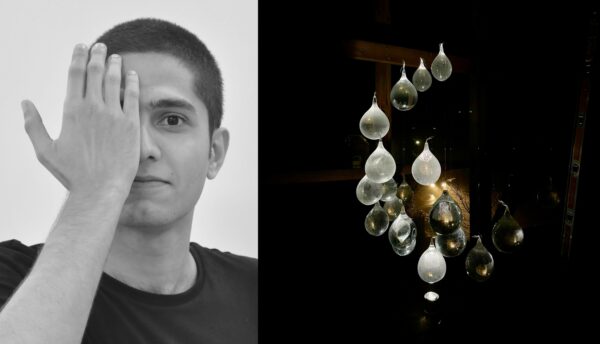
Moist Sparkle / Arash Abbaszadeh
Could you tell us a little about yourself?
My name is Arash Abbaszadeh, an architect born in 1992 in Iran. My journey in architecture and interior design began in 2010, and over the years, I’ve cultivated experiences in residential and hospitality design. Currently, I’m embarking on a new chapter, pursuing my second master’s degree in architectural lighting design at Wismar University in Germany. This academic endeavor represents a significant step in my commitment to exploring innovative intersections between light and space.
Can you explain the concept behind Moist Sparkle? How did you take inspiration from old German literature and apply it to the design?
“Moist Sparkle” was an artistic endeavor that sake to capture the ethereal interplay between morning dew and light. phenomenon The concept draws its inspiration from metaphors found in German literature, where the incidence of morning dew on spider net is poetically likened to moisture on silver hair. This metaphor serves as the heart of this human scale installation, creating scattered moist sparkling drops into space that resonate as both strange and familiar in the viewer’s subconscious.
The aim was not just to create a physical representation of this natural occurrence but to evoke emotional connections with the sound of rain and winds into the cold abandoned edge of the building. By translating the metaphor into a visual and immersive experience, the installation tried to become a poetic dialogue between nature, literature, and light.
Can you describe the process behind the creation of the droplets? How did you play with the salt and water concentration to achieve different glass formations?
The creation of the droplets involved a very experimental process. An incomplete sphere was formed, and within it, droplets were scattered. Each droplet contained varying concentrations of salt and water. The project sought to employ a narrow beam spotlight to graze the droplets, revealing the intricate frozen details within.
The delicate appearance of light within frozen water was achieved through the careful consideration of salt concentrations. By utilizing a very cold color temperature light source, the project aimed to highlight the minuscule bubbles within the drops, creating a visually stunning experience. This experimentation with salt concentrations became a central focus, requiring numerous iterations to find the delicate balance between a semi-frozen sparkle and a murky appearance.
What was the vision behind the use of cold artificial light with the blue tones of northern European winters? How do these light fixtures enhance and play with the glass droplets?
The vision for incorporating cold artificial light with the blue hours of northern European winters was rooted in the desire to experiment with the interaction of winter horizon sun rays in the open corner of the gallery. The chosen color temperature elegantly intersected with the extended blue hours of northern Germany during winter.
The chosen color temperature served to vividly illuminate the minuscule bubbles within the drops with the coldest appearance, enhancing the overall visual experience. The incidence of light within glass-like droplets resulted in a captivating interplay that captured the essence of the chosen inspiration, morning dew, and its poetic nuances.
What challenges did you face during the design process of Moist Sparkle? How did you overcome them?
The primary effective challenge was the maintenance of salt concentrations within the droplets. Achieving the perfect refraction required a delicate balance that necessitated numerous experiments and adjustments.
The project did not attempt to prevent freezing but rather embraced it as part of the artistic expression. Determining the right amount of salt for a semi-frozen sparkle, as opposed to a murky appearance, demanded meticulous experimentation.
Moreover, the fluctuation of humidity emerged as a significant factor that needed careful consideration. Overcoming these challenges required a combination of artistic intuition and persistent experimentation. The project’s success in maintaining the concentration of salt, resulting in clear water during daylight and crispy water with outer dews until dawn, stands as a testament to the dedication invested in overcoming these challenges.
How did you apply sustainability to your design?
A decade ago, sustainability might have been a controversial approach to design, but nowadays, it is an essential aspect integrated into all design spirit. Though the project didn’t explicitly delve into sustainability discussions, it subtly conveys a message between the lines about the interconnectedness of nature, light, and artistic expression.
Congratulations on winning the LIT Awards, “Emerging Lighting Product Designer of the Year” grand title. Are there any new projects you’re working on at the moment that you can tell us about?
Currently, I am engaged in a year-long internship at The Flaming Beacon, Berlin studio. This experience is providing me with invaluable insights as I collaborate with my esteemed colleagues, focusing on high-end residential projects that serve global clients.
The exposure to such high-standing projects is expanding my skill set and offering opportunities to contribute to the broader discourse on architectural lighting design.
Last, what can we wish you for 2024?
As we look ahead to 2024, I appreciate your mesmerizing efforts in spreading the lighting design culture by promoting great examples of architectural lighting design practices. My hope for the coming year is to witness a social improvement in understanding the substantial difference between designing with light and superficially merely lit facades, and the significance of architectural lighting design.
May the small community of lighting design continue to evolve and foster a transformative power of light in our built environment. I wish for continued growth, inspiration, and meaningful contributions in the realm of architectural lighting design.
Welcome to our interview with Eleftheria Deko, the force behind Eleftheria Deko & Associates, a renowned lighting studio specializing in architectural, stage, and event lighting. With extensive experience in diverse projects, Eleftheria and her team provide tailored lighting solutions for a wide range of spaces.
Eleftheria Deko, the founder, not only leads this creative studio but also imparts her knowledge as an Assistant Professor at the Theater Department of the School of Fine Arts at the Aristotle University of Thessaloniki.
Having designed lighting for over 450 theatrical plays, operas, music events, multimedia shows, dance performances, and architectural lighting schemes, Eleftheria has earned acclaim and awards globally. We’re here to discuss her recent success at the LIT Lighting Design Awards 2023, where her project “Persephone Reconsiders Her Fate” was honored as the Entertainment Lighting Design of the Year. Join us as Eleftheria shares her insights into the creative process and the significance of lighting in shaping artistic and architectural experiences.
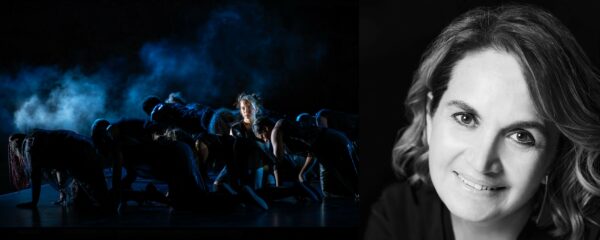
“Persephone Reconsiders Her Fate”. Photo Credits: Gavriil Papadiotis / John Stathis. // Eleftheria Deko
What was your inspiration behind your artistic rendering of the myth of Persephone through lighting and projection?
This specific myth served as our inspiration. Analyzing the story of Persephone, who was abducted by Hades and descended into the underworld before returning to the upper world again, we saw it as a symbolic journey into our inner selves, navigating the realms of the conscious and subconscious. Our challenge was to visually depict this journey, enhancing the intention of the choreography and using lighting symbolically.
Can you tell us how you used lighting to portray the living world and the underworld?
Varied hues and intensities distinguished the living world with warm, vibrant tones. The underworld was draped in cool, shadowy lighting, employing contrast to evoke distinct or unknown feelings. Beams of light coming through the inside of our set/wreck boat or moving from the top downwards created a supernatural atmosphere. The video projection sometimes followed the choreography, while at other times, it created a second depth – a deeper layer of interpretation.
Were there any challenges you faced while developing the projection and lighting design, either technical or conceptual?
The major challenge was time…: to be ready on time.
Technical challenges involved the mapping of the boat for the projection. Also, to place the lighting equipment in positions that would not create a visual nuisance, sometimes even sacrificing a good angle position.
Can you tell us more about the backdrop of the projections and performance, the ship Logos? Was it always meant to be a part of the narrative or did you have to adjust the lighting design to include it later in the design process?
It was our deliberate decision to position our stage directly in front of the ship Logos. Logos was a significant partner and the ideal set, it was chosen for its decadent ghostly appearance, symbolic name, and its proximity to the sea and its surroundings. Additionally, the ship’s textured surface served as the perfect projection screen. At times, the lighting created an illusion of emanating from within, giving the ship a supernatural vitality. In other moments, video projections on the ship added a multi-dimensional aspect to its personality or provided a serene backdrop, creating a darkened depth for the choreography.
After winning the “Lighting Design of the Year” in 2021 with the new lighting of the “Acropolis of Athens and other monuments”, congratulations on receiving the “Entertainment Lighting Design of the Year 2023. What does it mean to you personally to be awarded for this project?
Two years after that incredible honor, receiving the 2023 “Entertainment Lighting Design of the Year“ is another great honor, and it holds personal significance due to its strong emotional connection to Eleusis, the ancestral home of my father’s side family. The project was unique in many ways, addressing both personal and universal issues, and it marks a new cycle of artistic expression for me alongside Mystery 89, a Light Art Installation. I am immensely grateful to LIT and the jury for this amazing recognition!
How do you see the future of stage lighting design evolving? Do you have any advice for young lighting designers who would love to follow in your footsteps?
Stage lighting is poised to integrate more advanced technologies, and digitized realities, elevating immersive experiences, and illusionary spaces.
I would advise the young generation of lighting designers not to blindly follow technology or use it solely to impress, but instead to harness technology to create magic with light, emotionally move the audience, inspire people mentally, and elevate their spirit. Because lighting has the power to do such things! Light is a universal language that connects us all!
Last, what should we wish you for 2024?
I strongly wish for peace and for the enlightenment of the people who govern the world. I also wish for the inner light of each one of us to stay lit, guiding us away from darkness and into the beauty of life.
We recently had the pleasure of engaging with a luminary in the world of lighting design, Mr. Ryan Salim, the founder and principal in design of ERRELUCE. With a unique perspective on design concepts and a belief that ‘being less is the idea to get more perspective,’ Ryan brings a fresh approach to the world of lighting. He has elevated the art of seeing space within light, ensuring a delicate balance between emotion and quality in both interior and architectural settings. His philosophy centers around collaboration, firmly believing that it is through collaborative projects that design potentials can truly be realized.
ERRELUCE, an award-winning lighting design consulting practice based in Jakarta since 2015, is a testament to Ryan’s commitment to collaboration and communication throughout the design process. One of the achievements of ERRELUCE includes winning the Architectural Lighting Design of the Year at the LIT Lighting Design Awards in 2023. Their award-winning project, IronPlate Restaurant, blends French-inspired dishes with a distinctive Asian influence, prepared live in front of diners. The restaurant’s design showcases a captivating play of black textures, strategically placed lighting elements, and a sustainability approach that integrates reused lighting system controls for energy efficiency.
Throughout this interview, we explore Ryan’s design philosophy, the unique challenges and triumphs of ERRELUCE, and the exceptional blend of emotion and quality in their lighting designs.
Working with a “black on black” theme can be challenging, what was the inspiration behind the lighting design of the IronPlate Restaurant?
Black color indeed absorbs most light. However, it can also be used to an advantage, just like a blank canvas to play with light. Not many restaurants are willing to experiment with black and textures. Our idea was to use colors and unique materials provided by DSN Intervention, our collaborator in the interior design team. We started with a stainless ripple effect, sho sugi ban wood technique, a texturized stone wall, and even a textured paint cooper ceiling accent. We then focused on the details, plotting, and techniques on how to highlight those materials and enhance their beauty and maximum potential. Plotting the lighting points was also crucial, as we needed to keep it clean and simple but on point to highlight the designated objects. Some areas, where the ceiling is even irregular and wavy, were challenging for us to set a proper and unique beam to the bottom. Implementing the zigzag idea helped break the regularity and blend in with the main ceiling irregularity. Lastly, glowing up and popping up the fresh ingredients at the heart of the kitchen is one of the key points where all customers sit and see the crucial role of their dishes. Lighting indeed plays a significant role, and, of course, there is always room for improvement in our design.
Can you explain how lighting is used to enhance how the clients experience the restaurant’s Franco-Asian cuisine and cooking shows?
We also learned from the head chef, Chef Andri, who provided us with feedback on the cooking shows. The idea for the shows originated from him, so we considered his experiences and ideas. We created an ambiance where all eyes are focused on the large stainless steel surface where all the fresh ingredients are processed and cooked. We used two ceiling spotlights with a narrow beam angle of about 15 degrees and a warm tone of 2700K, providing a CRI95 grade of light quality to enhance the natural colors, textures, and smoke. These spotlights helped eliminate any shadows that might be cast while the cook was preparing the food. Our primary intention was to create an Instagram-worthy view that would appear beautiful on camera.
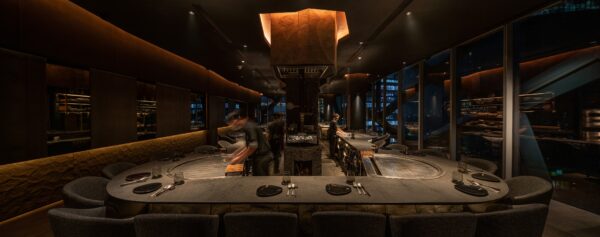
Photo Credits: FotoPerspektif, Ryan Salim
What led you to choose all the types of lighting fixtures used in the restaurant, such as the spotlights and LED strips?
We don’t use many types of fixtures in our design; instead, we focus on details and lighting placement to enhance the interior materials. Using too many types of lights can create color and character issues. For our main indirect light, we utilize an LED strip with 320 dots and 8W/m CRI90 2700K, and labeled as 24VDC. We also employ accessories to support the position on the furniture.
Next, our main general light utilizes an almost trimless fixture with a 75mm diameter housing painted black and honeycomb accessories to reduce glare. The bulb is a module LED with a COB chip rated at 6.5W and 10W power, 2700K with CRI95, and a 15-degree beam angle. It is phase-cut dimmable to match the old dimming system from the previous restaurant.
Lastly, we incorporate a recessed mini spotlight with a 45mm diameter painted black. The LED COB chip is rated at 3W, 2700K, 24D CRI90, and is phase-cut dimmable. This spotlight helps build up the ambiance and highlights key features.
Can you tell us more about the sustainable aspects of the lighting design and why it was important for you and the client to have a thoughtful approach to the project?
The most significant factor in this project is how we repurpose lighting control system components from the previous restaurant. These components were incomplete in their original quantity, as is common in restaurant designs. Most of the dimming modules were lost during the demolition of the previous restaurant. The client’s challenge was how to incorporate the available components and integrate them into the new design while creating a fresh ambiance.
What is even more surprising is that the system has to accommodate two restaurants, one of which won the LIT Lighting Design Award in 2022 (Wabi-Sabi restaurant). For us, this presents a substantial design challenge to ensure everything works seamlessly and creates a unique atmosphere aligned with our ideas and the client’s vision.
Can you share some of the challenges faced during this project? What did you learn and how did you overcome them?
Flexibility is crucial for us as interior design evolves to meet the needs of clients and sites. Additionally, new and challenging materials, such as stainless steel with a ripple effect, are introduced, making it almost impossible to find the optimal position for the light to shine on. Consequently, we need to check, re-mark, and reposition some lights based on the material positions.
The final challenge lies in the complexity of material combinations proposed by interior designers. Achieving harmony between color and light distribution is essential in lighting design. By paying attention to lighting placement details, we ensure that all lights contribute to a smooth and clean aesthetic.
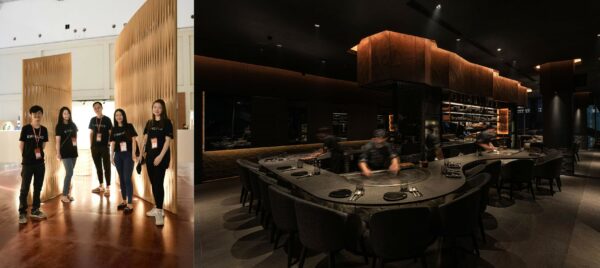
ERRELUCE team / IronPlate Restaurant. Photo Credits: FotoPerspektif, Ryan Salim.
Are there any future projects or visions you’re exploring that you can share with us?
We have worked on numerous projects with various architects and interior designers, which has allowed us to explore different design styles, materials, and details. Collaboration is fundamental to our design philosophy, and we will continue to grow and experiment with different types of design areas through our work with diverse clients and designers.
Congratulations on winning the LIT Lighting Design Awards! Is there any advice you’d like to give to future lighting designers? What would you have liked to know when starting your career?
Thank you so much! Winning the LIT Awards is truly an honor. For future lighting designers, I would advise them to always remain curious and open-minded. Lighting design is a constantly evolving field, so it’s essential to stay up-to-date with the latest technology and techniques.
Reflecting on my early career, I wish someone had told me that mistakes are a natural part of the learning process. Don’t be too hard on yourself if things don’t go as planned. Instead, view it as an opportunity to learn and grow. Always trust your instincts – they will guide you in the right direction.
In a shining moment for the world of lighting design, DarkSky has emerged as the winner of the esteemed Spotlight Prize at this year’s LIT Lighting Design Awards 2023. Nominated by the discerning jury, DarkSky received the award for their outstanding commitment to a mission: preserving the darkness of the sky.

“We are honored to receive this recognition from the lighting design community, with whom we have much in common. Well-designed outdoor lighting and responsible, dark-sky friendly lighting are synonyms. Both are sustainable, energy-efficient, environmentally responsible and pleasing to the eye,” says Tom Reinert, President of DarkSky.
The Spotlight Prize was introduced in 2020 aiming to put the “spotlight” on an organization, association, project, or initiative carrying out outstanding work for its community. At the same time, this winner has to be a contributor to the Lighting industry. In the past years, the LIT Lighting Design Awards honored different projects including the LUCI Association and Women in Lighting.
Previously known as the International Dark Sky Association (IDA), DarkSky is a United States-based non-profit organization established in 1988 by founders David Crawford and Tim Hunter. The mission of the IDA is “to restore the nighttime environment and protect communities and wildlife from light pollution”.
The Birth of DarkSky
For one of the founders of DarkSky, Tim Hunter, observing the Milky Way was something natural that he could do through the trees surrounding his home. Gradually, he became aware that the stars started disappearing from urban and suburban areas due to increased light pollution.
In 1985, he received an unexpectedly large tax return. He decided to buy a piece of land in a dark-sky area for a large telescope. One thing led to another, and soon he was the owner of 20 acres of land 40 miles southeast of Tucson, Arizona, on a high grassland plateau at an elevation of 5,000 feet. This is how the Grasslands Observatory was born. During this time the Dark Sky Office at Kitt Peak National Observatory had been headed by Dr David Crawford. Hunter and Crawford met several times to discuss their concerns about lighting recommendations. What started off as a contentious discussion developed into friendship and a mutual goal of protecting night skies.
According to Hunter, light pollution is a relatively easy environmental problem to solve but no one is doing anything about it. He then suggested forming a non-profit organization devoted to combating light pollution.
What is light pollution?
Most of us are familiar with air pollution, water pollution, and soil pollution. But there is something else that can be a pollutant, namely light. While electric light at night can be a great thing, guiding us home, keeping us safe, and making our homes cozy, it also has another impact on the environment. Light pollution is the excessive or inappropriate use of outdoor artificial light. Furthermore, it is the human-made alteration of outdoor light levels that occur naturally.
It affects human health, wildlife behavior, and our ability to see stars. In this context, DarkSky educates the public and certifies parks and other places that have worked to reduce their light emissions.
When we over-light, fail to use timers or sensors, or use the wrong color of light, we can negatively affect so many parts of our world, including migratory birds, pollinators, and mammals. Research suggests that artificial light at night can negatively affect human health as well as increase the risk of depression, sleep disorders, obesity, and more. According to a recent paper, “There is an increasing number of research underlining the complexity of the correlation between light pollution and Alzheimer’s disease; however, additional studies to enhance the key tenets are required for a better understanding of this relationship.” Wasted light wastes money. Outdoor light emissions represent at least one percent of global energy use – contributing to the climate crisis. Globally we spend at least $50 billion in energy costs to produce light that escapes into space.
Components of light pollution include glare (excessive brightness that causes visual discomfort), sky glow (brightening of the night sky over inhabited areas), and light trespass (ligh falling where it is not needed). Unfortunately, light pollution is a side effect of industrial civilization. Fortunately, there’s a growing awareness that the ways we stave off the dark can actually have detrimental effects too. Most of the light pollution comes from cities, outdoor lights, streetlights, electronic advertising, parking lots, sports lighting, factories, greenhouses, gas production, and rural places.
Some of the ways to attempt to solve the problem of light pollution are following responsible lighting practices, passing dark sky-friendly legislation, and advancing scientific research in this field. These are also some of the practices that DarkSky has undertaken on their journey.
DarkSky – Who are they and what do they do?
DarkSky’s goal is to tackle these issues and create a better environment not only for the wildlife but also for us, humans.
Currently, DarkSky has more than 190,000 supporters, members, and advocates in more than 70 countries. They provide tools and resources for individuals, policymakers, and industry to reduce light pollution and promote responsible outdoor lighting that is healthy and functional.
“DarkSky looks forward to future opportunities to work with lighting designers and lighting manufacturers to develop and to deliver lighting solutions that restore the nighttime environment and protect wildlife and communities from the harmful effects of light pollution,” states Ruskin Hartley, CEO and Executive Director of DarkSky.
What made DarkSky stand out in comparison to the other nominees for the spotlight prize at the LIT Lighting Awards are some of their main practices. Their professional methods amongst others include education and advocacy efforts, building a strong sense of community through various events, and impacting the world by reducing light pollution. DarkSky tries to achieve this by certifying and conservating starry sky parks, communities, and other places around the world. Moreover, they certify commercial, industrial, and residential outdoor lighting that reduces light pollution.
The first method implemented to handle light pollution is certifying conserving the dark sky places. Currently, there are over 160,000 square kilometers of protected land and night skies in 22 countries on 6 continents, and the list grows every year. The night sky and the nocturnal environment are naturally and historically important resources worthy of conservation. Certified places are therefore required to use quality outdoor lighting, effective policies to reduce light pollution, and ongoing stewardship practices.
DarkSky has also been spreading the word about light pollution since 1988. They often organize conferences and trade shows that bring together a variety of policymakers, scientists, and government representatives amongst others to discuss night sky preservation. The DarkSky staff and volunteers also give talks, presentations, and exhibits at events such as the annual Light Fair, the European Symposium for the Protection of the Night Sky, and more.
Furthermore, DarkSky hosts an annual virtual conference each fall. It takes place over a 24-hour period, connection advocated and supporters of the dark sky movement for around the world. There is another event, called the International Dark Sky Week which will be held in April 2024. It aims to invite people from over the world to reconnect with he benefits of a dark, star-filled sky and learn how to reduce the negative impacts of light pollution on human, wildlife, and ecosystems.
One of the most important lessons that DarkSky teaches is adopting responsible means of lighting and illuminating spaces. It is no surprise that light brings huge benefits to modern society. It has revolutionized how we live and work outdoors. The modern society of the 21st century requires outdoor lighting for many reasons including safety and commerce. Therefore, DarkSky advances responsible outdoor lighting through policy solutions, public education, and scientific research. In this sense, responsible outdoor lighting allows people to see at night, conserves energy, and avoids harmful effects on wildlife. It is also useful, targeted, controlled, and warm-colored.
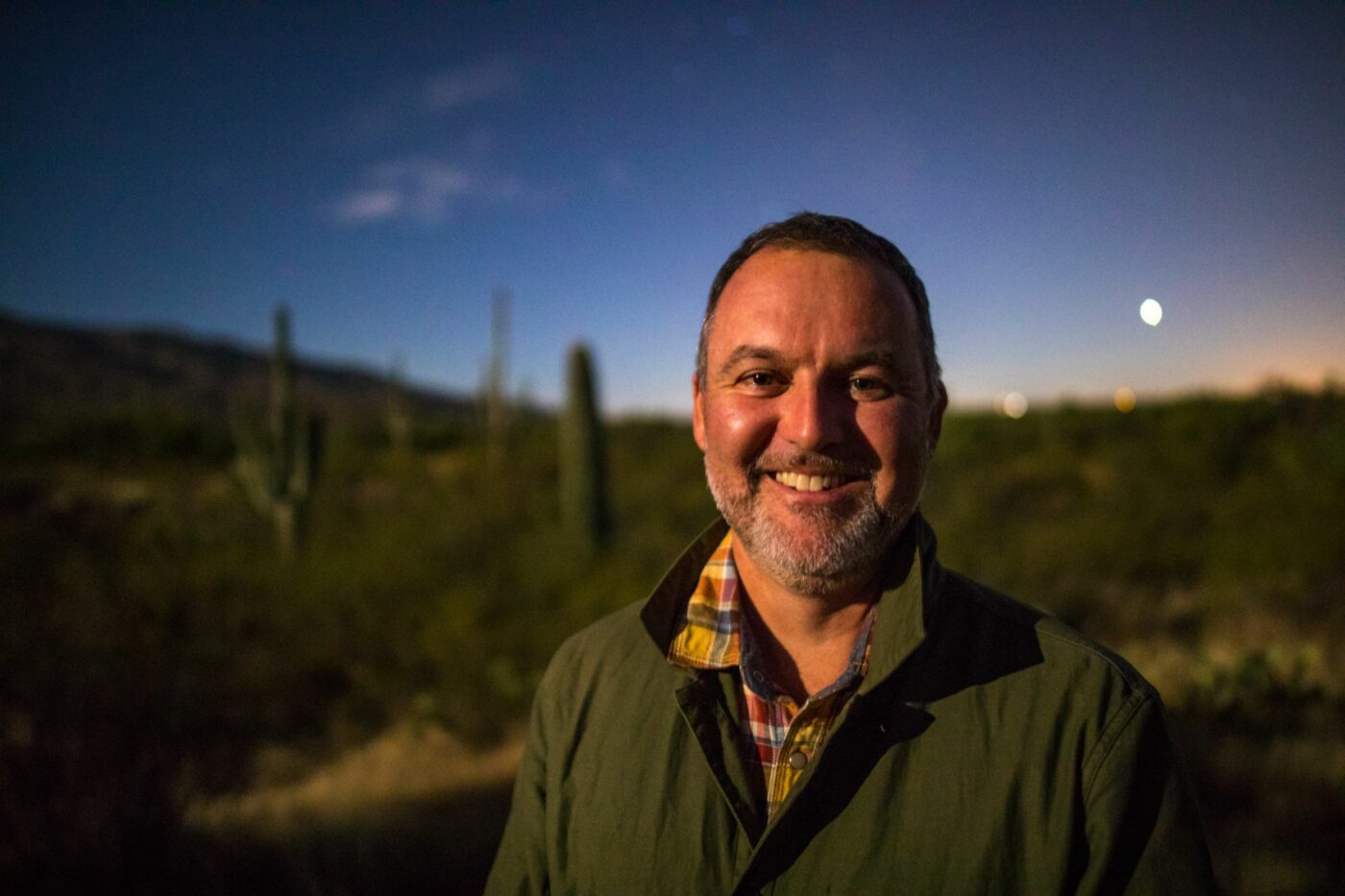
Last but not least, DarkSky‘s approved program provides objective, third-party certification for products, designs, and completed projects that minimize glare, reduce light trespass, and don’t pollute the night sky.
To achieve their goals DarkSky has partnered with different organizations such as CBS, National Geographic, Clear Sky Chart, Globe at Night, Under Canvas, Your True Nature, Selux, and many more. In this way, they have the opportunity to receive support and sponsorship for their programs and events. At the same time, it allows for further world reach and global education.
“DarkSky International strives for and promotes lighting practices that reduce the negative impacts of light pollution on wildlife, biodiversity, climate change, and human health. This recognition from the lighting design community beautifully illustrates the relationship between good lighting design and responsible dark sky-friendly lighting. Through responsible practices and innovative design we can combat the alarming trends of lighting pollution together,” concludes Hartley.
DarkSky’s receipt of the Spotlight Prize at the 2023 LIT Lighting Design Awards speaks volumes about their steadfast commitment to combat light pollution and champion responsible outdoor lighting practices. Their dedication to education, advocacy, and the certification of dark sky places positions them as leaders in the pursuit of sustainable and environmentally responsible lighting solutions. As DarkSky continues to light the way toward a harmonious coexistence of light and nature, this prestigious recognition underscores the crucial link between innovative lighting design and the promotion of responsible, dark-sky-friendly practices.
Text: Polya Pencheva